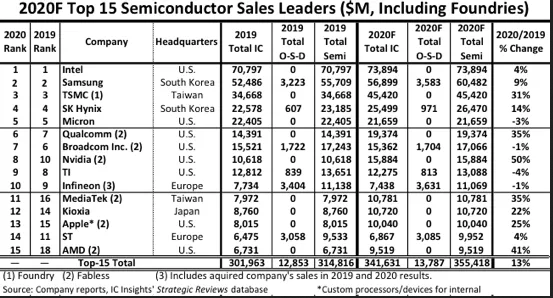The coronavirus threw the world economy into a tailspin, but that didn’t slow down the semiconductor industry, according to industry soothsayer IC Insights. Instead, chipmakers enjoy booming revenues, the company projects it would boost sales by 13% in 2020 for the entire industry, twice the original forecast. That’s quite the 2019 bounceback, which found a 15% shrink in industry revenue.

The list is based on the company’s forecasts for the final results of 2020 revenue, and given that we are in the final stretch of 2020, it should be close to the final numbers. The report also reminds us that AMD, Apple, and Nvidia all lack the sheer production volume of Intel. Intel generated twice the income of those three businesses, combined.
Even as it faces an uncertain future due to its ongoing manufacturing difficulties, Intel continues to report impressive sales. As expected, with $73.89 billion in IC sales this year, Intel should stick to its leading position in the industry. That’s a 4% improvement over 2019. Samsung is coming in a near second, but there’s still quite a difference. Intel’s revenue trails by 22%.
The list includes companies that do not make their own chips, too. The hard-charging AMD appears for the first time on the top 15 semiconductor sales leaders list, landing in fifteenth place with a 41% revenue boost, propelling it from its previous position in eighteenth place.
Putting AMD’s estimated $9.5 billion in IC sales next to Intel’s $73.9 billion is a clear reminder that the startling comeback of AMD has really occurred against all odds: Intel’s revenue is still 7.8 times greater even after AMD’s three years of exponential development.
Interestingly, on the list that does not sell chips to the open market, Apple, the lone producer on the list, lands in 13th position, beating AMD by ~ 5.5 % and notching a growth rate of 25% year over year. We might see even greater growth next year now that Apple is in the desktop PC chip design game with the Apple M1 chips.
Nvidia, another fabless chip maker, has the best showing in terms of annual sales growth with a forecast % annual revenue increase, hitting the tenth position on the 2020 projections list. That’s a lot of GeForce and data centre graphics cards, but it’s important to remember that while the growth of Nvidia is explosive, we’re not sure if that includes its acquisition of Mellanox. Also, the new generation of graphics cards from Nvidia is not even completely on the market yet – shortages affect the entire industry, and Nvidia is no exception. Given the success of the Ampere series, if supply stabilizes, we might see the company report even greater gains next year.
The pandemic has largely spurred stellar growth in the semiconductor industry, and unanticipated demand has punished all of these firms with a series of rolling shortages. For now, in order to avoid sudden and massive over-supply situations when the pandemic inevitably recedes, the task is for those industries to carefully monitor any production expansions. An oversupply is not good for business or profits, so we can expect chip production to expand slowly but surely, which could limit potential short-term growth rates.

1 Comment
Pingback: AMD Ryzen 9 5900HX Outpaces Intel Core i7-10700K as it Hits 4.7 GHz - Craffic